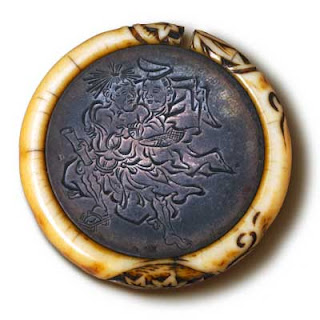Besides collecting Japanese wood block prints, porcelain and lacquerwork, Charles began assembling his collection of netsuke.
Japanese netsuke (pronounced net-skeh) are miniature sculptures that served a decorative and functional purpose. They were used on mens kosode and kimono robes. Because the kimono's had no pockets they needed something for storing personal belongings such as tobacco, currency and other items. The solution was to use a pillow form pouch called "sagemono"or "Inro", which were made from a variety of materials such as wood, lacquer and shagreen or even finely woven baskets.
Inro with "ojime"and a "sashinetsuke"
Netsuke became art in itself and were made in a variety of forms and materials.
Forms-
Katabori Netsuke- Sculptural and the most common of netsuke and carved in round shapes.
The hare with amber eyes
Anabori netsuke- Carved with hollowed centers. The clam was the most popular form
Sashinetsuke- Elongated forms with fine carvings
Obi hasami netsuke- Another elongated form but curved at the tops and bottoms. The tops and bottoms would be visible above and below the obi.
Mennetsuke- Netsuke carved into a mask form, which was also a popular and common form
Manjunetsuke- Round, donut like forms with relief carvings
Ryusa netsuke- Similar form as the manjunetsuke but with translucent, lacelike carving
Kagamibutnetsuke- "Mirror lid netsuke" shaped like the manju but with a metal disk.
Karakurinetsuke- Netsuke with moving parts or mechanisms
Materials-
Netsuke were made in an astonishing variety of luxurious and sometimes rare materials including ivory, boxwood, metal, hippopotamus tooth, boar tusk, rhinoceros horn, hornbill ivory, clay, lacquer and cane.





































No comments:
Post a Comment